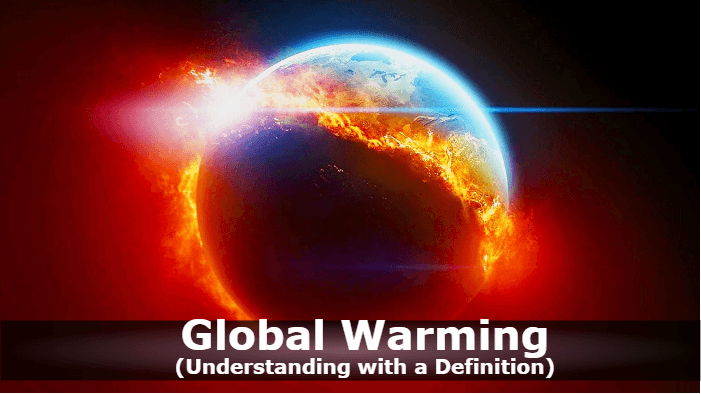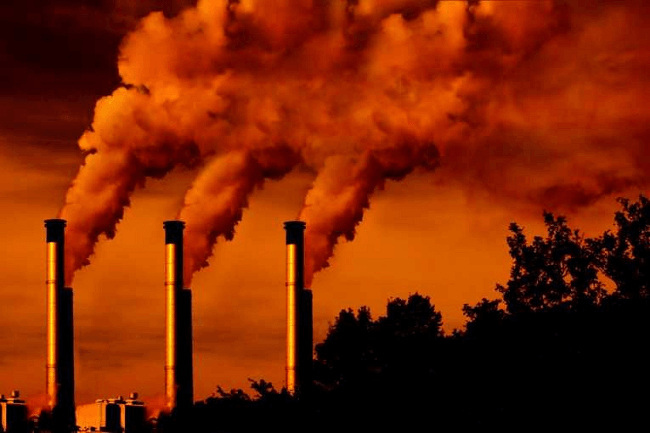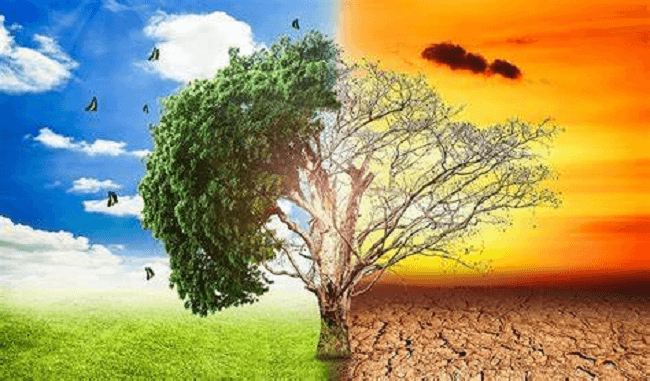Global Warming DefinitionThe gradual temperature rise found close to the surface of the globe or Earth is known as global warming. Over the previous two or three centuries, this pattern has been noted. This change has affected the Earth's climate cycle. Although global warming is debatable, scientists have offered evidence to support the idea that the Earth's temperature is growing steadily. Several causes of global warming negatively impact humans, plants, and animals. These reasons might result from human activity, or they might be natural. Understanding how global warming negatively affects society is crucial for tackling the problems that may arrive in the future. 
Causes of Global WarmingGreen House EffectThe greenhouse effect has increased the complexity of the Earth's energy balance. Nitrous oxide (N2O), methane (CH4), and Carbon dioxide (CO2), the so-called greenhouse gases, are trace gases with particular chemical properties which absorb some of the infrared radiation emitted by the Earth's surface. This absorption prevents some of the original 70 units from going into space. Because of the uniform distribution of the radiation and the fact that greenhouse gases emit the same amount of radiation in all directions, the net effect of absorption by greenhouse gas emissions is to raise the total quantity of radiation that is emitted downward toward the Earth's surface as well as the lower atmosphere. By preserving a balance between various types of solar & terrestrial radiation, the Earth's average surface temperature is kept constant. Since solar radiation has extremely high frequencies with short wavelengths near the visible region of the electromagnetic spectrum, it is frequently referred to as "shortwave" radiation. Terrestrial radiation, in contrast, is usually referred to as "longwave" radiation because of its relatively low frequencies and long wavelengths located in the infrared part of the spectrum. It is common to measure the downward-moving solar energy in terms of watts per square meter. The "solar constant", or total solar radiation, is found above the peak of the Earth's atmosphere, or about 1,366 watts per square meter each year. Averaging 342 watts per square meter annually, surface insolation explains why about 50% of the Earth's crust is exposed to solar radiation. Radiative ForcingThe temperature of the Earth's surface and lower atmosphere can be changed in three different ways, according to the greenhouse effect debate from earlier. According to the theory of radiative forcing, any of the following situations can have alterations:
Climate Change as a Result of Human ActivityHuman activity also affects the climate by changing the levels of ozone and aerosols, as well as the land cover on the surface of the planet. For instance: Greenhouse GasesBurning fossil fuels, cutting down forests, and farming livestock are some notable examples that are significantly affecting the atmosphere and the overall temperature within the atmosphere. Additionally, it participates in adding significant amounts of greenhouse gases to the atmosphere, further increasing global warming. When the gases are released into the atmosphere, more net downward longwave radiation is produced, which ultimately causes more heating at the Earth's surface. Water VaporEven while it alters the climate, it does not directly impact the planet's warming. With the constant increase in surface temperature, water evaporation rates increase accordingly. Greater concentrations of water vapor, which can collect longwave radiation and emit it downward, are present in the lower atmosphere due to higher evaporation. Carbon DioxideFrom both plants and animals, carbon dioxide is generated. Anthropogenic Emissions of CO2 have contributed 1.66 watts per square meter of radiative forcing on average since the dawn of the industrial age. Methane Methane (CH4) ranks as the second-most critical greenhouse gas. Methane concentrations have altered across a limited range due to Pleistocene ice age cycles (between roughly 350 & 800 ppb). Anthropogenic CH4 emissions are much more potent than CO2 emissions, having a net radiative forcing of around 0.5 watts per square meter, or around one-third of CO2. Surface Level Ozone and Other CompoundsLow-level or surface ozone (O3) is another greenhouse gas that is critical to the atmosphere. Air pollution is what produces surface O3. According to the best estimations, its natural surface O3 content is around ten ppb, while human surface O3 emissions cause a net radiative forcing of about 0.35 watts per square meter. Ozone levels can become close to dangerous in cities prone to photochemical haze. Causes of Climate ChangeThere are two main categories of causes that affect the climate, such as:
Manmade CauseHigher Levels of Deforestation Deforestation impacts the aerosol and chemical compounds released, which affect clouds and alter wind patterns, changing the amount of precipitation. In a nutshell, trees and other plants provide most of the oxygen we breathe. They release oxygen into the atmosphere by absorbing carbon dioxide, preserving an ecologically balanced environment and reducing air pollution. The continuing destruction of forests for commercial and industrial purposes is one example of planned human activity increasing carbon dioxide concentrations. As one of the principal gases that trap heat, carbon dioxide has played a major role in recent decades' global warming and environmental imbalance. Vehicle Use and Transportation People frequently use autos in today's fast-paced environment, even to travel small distances. Gas from automobiles and other vehicles frequently causes temperatures to rise by sapping energy and turning it into heat. Such actions fall under "anthropogenic forcing", or forces that the climate system is subject to because of people. Transportation in crowded places continues to add to air pollution, which ultimately causes a rise in global warming. The IPCC (Intergovernmental Panel on Climate Change) states that one of the main contributors to global warming, the transportation sector, has increased its contribution by more than 50% since 1992. Emissions of Chlorocarbons We all know that human-caused factors have very strong tendencies toward growing global surface temperatures in the current condition of successive climatic imbalance and difficulties with global warming. The rising usage of technical goods like refrigerators and air conditioners, as well as extensive commercialization, are further contributing factors. The responsibility of protecting the Earth's heat from the sun's harmful ultraviolet rays falls on the ozone layer in the atmosphere. These operations have raised the atmospheric concentration of CFCs or chlorofluorocarbons, eroding the ozone layer. Emissions from Industries and Power Plants According to a 2018 report, about 52 billion tonnes of carbon dioxide is one of the largest global anthropogenic greenhouse gas emissions. About 72% of which is discharged from industrial and electricity facilities. Global warming has greatly grown with the onset of industrialization, the expanding use of energy, and the use of heat. These sources' releases of pollutants have a substantial negative influence on the ecosystem and upset the delicate balance of nature. 
Agriculture and Land Surface Changes Nearly half of the world's livable land is used for frequent agricultural activities. Approximately 24% of the permanent land-use change is impacted by short-term agricultural cultivation. These activities impact the temperature increase and the land surface's GHG (greenhouse gases) emissions. The natural store of carbon is disrupted by the changes to the land surface, which also impacts how sun heat is reflected and absorbed. As a result of increased runoff brought on by soil erosion, deforestation, and the application of chemical fertilizers, contaminants are eventually carried into the oceans by these factors. Combustion of Fossil Fuels, Overpopulation This category aids in the majority of the heat-trapping emissions produced due to burning coal, gas, and oil in businesses and automobiles, as well as extensive deforestation and rising amounts of black carbon pollution, sometimes known as "soot", which affects the Earth's albedo. In addition, carbon dioxide, the main gas responsible for global warming, is being affected by the increase in the world population. Natural CausesVolcanic Eruptions The eruptions are one of the main natural causes of global warming because of the rising emissions of gases and smoke they produce. Natural Forest Fires When large-scale vegetation burns, causing a forest fire, stored carbon is released, and greenhouse gas emissions increase. These pollutants capture more solar energy, which contributes to global warming. Melting Permafrost and Glaciers Permafrost, which is made up of significant amounts of carbon, is found at the planet's north and south poles. Disturbances like solar activity, forest fires, and volcanic eruptions can cause the abrupt release of greenhouse gases (GHGs) and carbon dioxide (CO2) through permafrost into the atmosphere, resulting in ecological imbalances. Solar Activities When occurs on a large scale, fluctuations in solar irradiance at different wavelengths and other phenomena, such as sunspots or solar flares, can have a profound effect on atmospheric temperature and global warming. Global Warming: Its Effects and ImpactsThe biggest effects of global warming are on society, the economy, and the health of the environment and living beings. If it continues at the same speed as it is going right now, it might inflict much damage in the future. The following are its specific effects: Rise in Temperature Leading to Ice Melt The mid-latitudes will see more frequent droughts and severe water shortages due to thawing glaciers and melting snow, which will also lead to extreme weather events like heat waves. The thinning of the ice cover in the North Sea will eventually make the atmosphere more vulnerable to control. Environmental Risks Drier climate regions, such as the subtropical deserts, have expanded due to global warming. Increasing carbon dioxide levels and rising temperatures will primarily impact ecosystems and animal life, causing many species to go extinct and reducing biological variety. 
The Threat to Marine Life Underwater marine and coral life may be destroyed due to global warming. Water with a higher carbon dioxide level damages priceless natural resources. Loss of Settlements Flooding could result from sea level rise caused by global warming, putting infrastructure and habitations at even greater risk. People's quality of life will be negatively affected by this. Agriculture is threatened by drought, rising temperatures, and the disappearance of glacial rivers. Factors Affecting Health Crop failures have several indirect repercussions, including malnutrition. Several diseases can be brought on by insufficient rainfall that causes desertification as a result of global warming. Potential Effect of Global WarmingThe scenarios are developed using a variety of projections for population increase, economic growth, energy demand, technological advancement, climate mitigation, and other factors. Simulations of the future impact of climate change include warning patterns. It is anticipated that the area of the North Atlantic Ocean south of Greenland will only be moderately warm. Changes in precipitation patterns are anticipated to increase the likelihood of flooding and drought in many regions, according to regional predictions, which include the following: Cooler polar air masses will migrate into the region as the jet stream moves, and warm northward ocean currents decrease. Increased winter precipitation inside the arid southwest region of the United States may worsen the current drought in South Africa and contribute to sea level rise, changes in ocean circulation, and tropical cyclones. Environmental Consequences of Global WarmingGlobal warming and climate change could alter biological processes. The diversity of plants, animals, and other life forms will, in turn, be impacted by variations in near-surface air temperatures, to put it more exactly. Due to adaptation to seasonal climate patterns over a lengthy period, plant and animal species have expanded into their current geographic ranges. If average global surface temperatures increase by some other 1.5 to 2.5 °C (2.7 to 4.5 °F) by the year 2100, many plant and animal species are predicted to be in increased danger of going extinct. Estimates of species loss rise to 40% for temperatures above 4.5 °C (8.1 °F), a threshold that could be reached under the IPCC's higher emissions scenarios. A 40% extinction rate would be damaging to ecosystem function since it would undoubtedly create large changes to the food webs within ecosystems. Socioeconomics Consequences of Global WarmingThe socioeconomic impacts of global warming may be significant, depending on how much the world's temperature rises over the next century. According to models, places would experience economic losses with a net increase in global warming of 1 to 3 °C (1.8 to 5.4 °F) over the global average in the late 20th century. In contrast, other regions would experience economic gains, particularly in the tropics and high latitudes. ConclusionIn conclusion, the threat of global warming must be taken seriously and urgently. In the future, if nothing is done to reduce greenhouse gas emissions, the consequences and impacts of global warming will worsen and already be felt worldwide. It will take a combination of actions to reduce emissions and adapt to the shifts that are currently happening to mitigate global warming.
Next TopicHerbs Definition
|
 For Videos Join Our Youtube Channel: Join Now
For Videos Join Our Youtube Channel: Join Now
Feedback
- Send your Feedback to [email protected]
Help Others, Please Share










